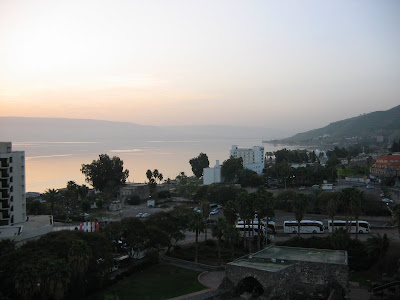
Caesarea Maratima also was the first artificial harbor in the world at that time. Although Josephus Flavius (www.answers.com.topic/josephus) had written all about the harbor, no one knew where it was located because it had sunk into the sea. The harbor was discovered in the 1950s. Our guide said that until fairly recent times, Josephus and his writings of the events and history of Israel were not taken too seriously because he was Jewish. Historians and archaeologists have found that Josephus's writings are accurate, down to the exact measurements of the size of the harbor. He was the only individual who documented the 3-year battle at Masada. The son of a Sadducean who lived in Rome, Josephus came back to Israel just as the Jewish rebellion was getting started (about 66 AD). Josephus actually talked with those who knew Jesus.
There currently are vast archaeological studies ongoing in the Caesarea Maratima area. The picture, below, is our view of the ruins of Herod's palace, taken while we were sitting in the theater. You can see some rocks in the middle of the picture, there are many more off to the left and outside of the picture. The archeologists are faced with a giant puzzle, attempting to match up and rebuild these buildings that were altered by earthquake and then buried.
.JPG)
The Roman procurator, Pilate, was stationed here at Caesarea Maratima. He traveled to Jerusalem the week of the Jewish Passover celebration because of concerns regarding potential Jewish uprising and riots. The archaeologists recently discovered a stone plate from one of the buildings that lists Pontius Pilate as the Roman procurator during this time. This stone, now housed in the History museum in Tel Aviv, provides solid evidence of the existence of Pontius Pilate as Roman Procurator at this time.
The below picture shows Herod's indoor swimming pool, also a recent discovery. All of Herod's palaces were known for their luxury.

The following picture shows the ruins of a room in the palace that historians and archaeologists believe may have served as the administration room in this palace. You can see the fire pit in the center of the room. Historians believe this very room was the likely place where Paul was tried. Cornelius (Acts, Chapter 10) lived somewhere in Caesarea. Cornelius was the first non-Jew (Gentile) baptised here in Caesarea, the baptism spurring great growth in the church.
.JPG)
This last picture is of the aqueducts built by Herod the Great in Caesarea.

It's so exciting to see all that they are discovering, today, in 2010. Unbelievable that excavations and research only started after Israel became a state in the late 40s, and incredible what they are finding, clear evidence of the truth in the Bible and the writings of Josephus, who actually spoke with those who knew Jesus.
.JPG)

.JPG)





